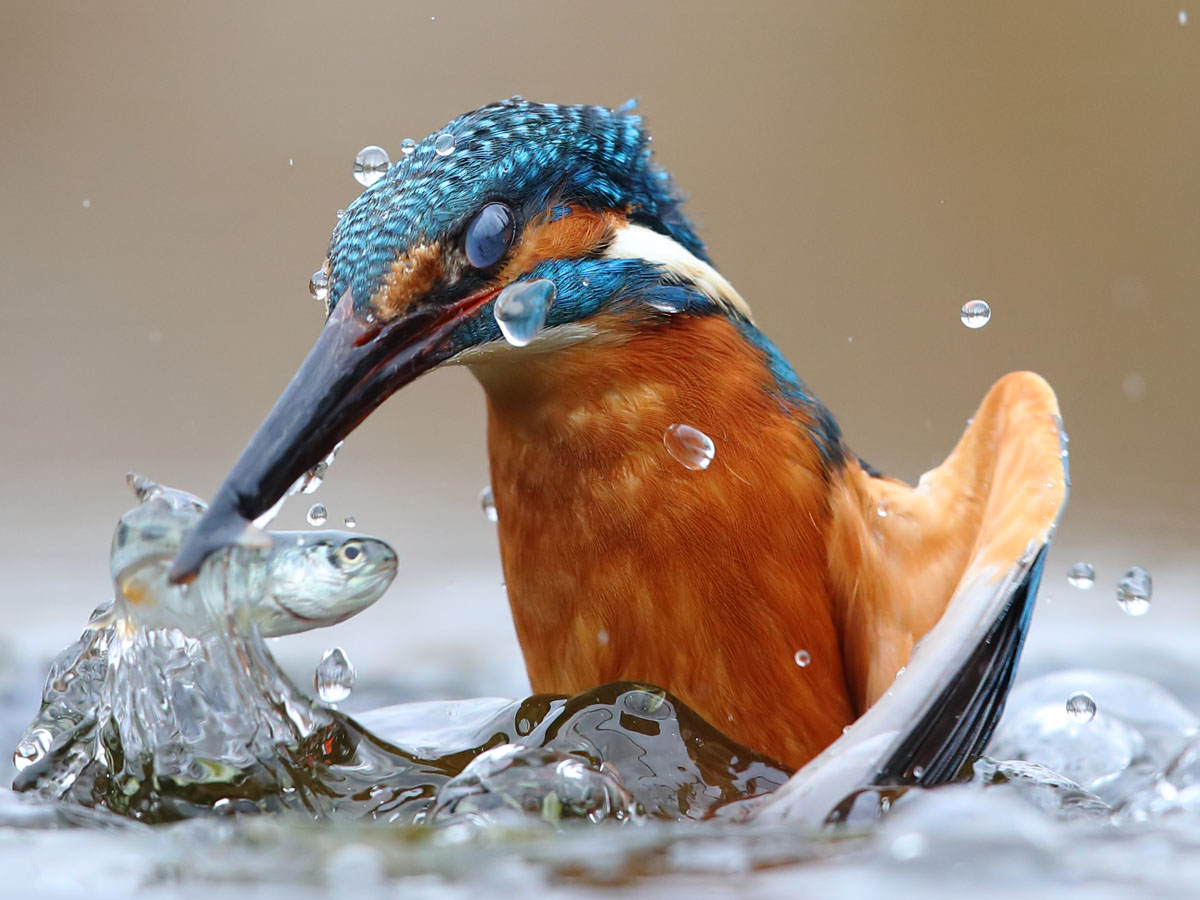THE WORLD BIRDS - An Online Bird Book
KINGFISHERs of The World - River Kingfishers
Order Coraciiformes Family Alcedinidae
KINGFISHERs of The World - River Kingfishers
Order Coraciiformes Family Alcedinidae
The kingfisher family Alcedinidae belongs to the Coraciiformes order, as do the bee-eaters of family Meropidae, the motmots of family Momotidae, the rollers of families Brachypteraciidae and Coraciidae, and the todies of family Todidae.
Kingfishers are a group of small to medium sized brightly colored birds in the order Coraciiformes. They have a cosmopolitan distribution, with most species found outside of the Americas. There are about 110 species of kingfisher. All have large heads, long, sharp, pointed bills, short legs, and stubby tails. The typical kingfisher has three toes pointing forward and one to the rear, with the third and fourth toes partially fused together. The bill is usually longer and more compressed in species that hunt fish, and shorter and more broad in species that hunt prey off the ground. Most species have bright plumage with little differences between the sexes. There is also little difference in the length or weight of the sexes. Some species have males slightly larger than females, but other species have the females listed as slightly larger than the males.
The kingfishers are separated into three subfamilies: River Kingfishers (Alcedinina), Tree Kingfishers (Halcyoninae), and Water Kingfishers (Cerylinae). This article is about the River Kingfishers which are also know as Pygmy KIngfishers.
The river kingfishers are one of the three subfamilies in the kingfisher group. They are widespread through Africa, east and south Asia as far as Australia, with one species, the common kingfisher, also appearing in Europe and northern Asia. These are brightly plumaged compact birds with short tails, large heads and long bills. They feed on insects or fish, and lay white eggs in a self excavated burrow. "River" can be somewhat of a misnomer for many of these species as they are not dependent on water for food. These Alcedininae kingfishers have also been called pygmy kingfishers. While the majority of this subfamiy are indeed small, there are quite a few exceptions to this characterization too. Approximately 20 species have "dwarf", "pygmy", or "little" as part of their name.
There are 39 Alcedininae kingfishers which are contained in 5 genera: Alcedo(7), Ceyx(22), Corythornis(4), Ispidina (2), Lacedo(1), and Pelargopsis(3) where the number in parenthesis indicates the species in the genus.
The Alcedo kingfishers all eat fish. Some also eat small crustaceans, aquatic insects, and larvae. The generally forage by sitting on a perch looking in the water below for prey. They all have some blue feathers on their upperparts and most species some rufous in their plumage and also have a black bill. The female generally has more red on the lower mandible than the male. The smallest species is the cerulean kingfisher which is about 13 cm long The largest is Blyth's kingfisher with a length of 22 cm.
All except one of the kingfishers in Ceyx have three rather than the usual four toes. The exception is the Sulawesi dwarf kingfisher which retains a vestigial fourth toe. They are found from South East Asia to the Solomon Islands. Compared to the related kingfishers in the Alcedo genus, the Ceyx kingfishers are more terrestrial and their diet consists mainly of insects. These are small kingfishers - the majority are less than 15 cm long. The six African species in Ispidina and Lacedo are also small, none longer than 14 cm. The largest of the Alcedininae kingfishers are found in genus Pelargopsis with the biggest being the great-billed kingfisher which is 35 cm long and can weigh up to 200 grams.
They Alcedininae kingfishers lay white eggs in a tunnel that is constructed in the ground by both parents. Both adults also incubate the eggs and feed the chicks. The length of the nest-tunnels depend on the size of the species and also the material in which the tunnel is constructed. These tunnels range from 5 to 100 cm in length. A large bird and soft material favors a longer tunnel.
Genus Alcedo
The Alcedo kingfishers all eat fish. Some also eat small crustaceans, aquatic insects, and larvae. The generally forage by sitting on a perch land looking in the water below for prey. They all have some blue feathers on their upperparts and most species some rufous in their plumage and also have a black bill. The female generally has more red on the lower mandible than the male. The smallest species is the cerulean kingfisher which is about 13 cm long The largest is Blyth's kingfisher with a length of 22 cm. Both partners help excavate nest-tunnels and incubate the eggs. The tunnels for these relatively small species average about 50 cm in length.
Kingfisher,_Blue-banded Alcedo euryzona
Description: The male blue-banded kingfisher has mainly dark upperparts, white underparts with a blue breast-band, and a black bill. The female has dark upperparts, a white throat, and rufous underparts. She has a black upper bill and a reddish lower bill. They are 20 to 21 cm long and weigh 40 to 45 grams.
Range: Brunei, Indonesia, Malaysia, Myanmar, and Thailand.
Habitat: Streams and rivers, usually beneath the forest canopy.
Diet: Fish, crustaceans, insects, larvae.
Conservation status: The blue-banded kingfisher is listed as Near Threatened because of deforestation.
Image by:
1) John Gerrard Keulemans 2) Mike_Prince 3) Mark Benedict - Borneo 4) lonelyshrimp - ThailandRange: Brunei, Indonesia, Malaysia, Myanmar, and Thailand.
Habitat: Streams and rivers, usually beneath the forest canopy.
Diet: Fish, crustaceans, insects, larvae.
Conservation status: The blue-banded kingfisher is listed as Near Threatened because of deforestation.
1) Left: male Right: female 2) Female 3, 4) Male



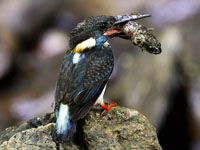
Kingfisher,_Blue-eared Alcedo meninting
Description: The blue-eared kingfisher has blue ear coverts, cobalt-blue upperparts, a white neck blaze, and rufous underparts.The blue-eared kingfisher has more blue on its face that does the similar common kingfisher The common kingfisher has white freckles on a blue head, the blue-eared kingfisher does not have white freckles. It is 15 to 17 cm long and 16 to 31 grams. Both pair excavate the nesting tunnel, incubate the eggs, and feed the chicks.
Range: Indian Subcontinent and southeast Asia, Malaysia, Indonesia, Philippines.
Habitat: Moving water in evergreen and wet deciduous forests.
Diet: Fish, crustaceans, insects, larvae.
Conservation status: Least Concern.
Image by: 1) ) David Dennis - Malaysia 2) Shrikant_Rao - India 3) David_Cook - BorneoRange: Indian Subcontinent and southeast Asia, Malaysia, Indonesia, Philippines.
Habitat: Moving water in evergreen and wet deciduous forests.
Diet: Fish, crustaceans, insects, larvae.
Conservation status: Least Concern.



Kingfisher,_Blyth's Alcedo hercules
Description: The Blyth's kingfisher has a blue back, rump, and tail. The underparts are rufous. It has a green face, neck, and wings, The throat and lores are white and there is a white patch on the side of the neck. It is 22 to 23 cm long making it the largest of its genus.
Range: Asia.
Habitat: Streams and small rivers which are usually in hilly wooded country.
Diet: Mainly fish. Also insects.
Conservation status: The Blyth's kingfisher is listed as Near Threatened as it is observed infrequently.
Image by:
1) Discovery_Times 2) Henry_Koh Range: Asia.
Habitat: Streams and small rivers which are usually in hilly wooded country.
Diet: Mainly fish. Also insects.
Conservation status: The Blyth's kingfisher is listed as Near Threatened as it is observed infrequently.


Kingfisher,_Cerulean Alcedo coerulescens
Description: The cerulean kingfisher, also known as the small blue kingfisher, has metallic blue upperparts. It has white lores and neck patch plus white underparts with an azure-blue breast band. The bill is black and the legs are dark brown. The male has a wider breast-band than the female. The female is duller. Both pair excavate the nesting tunnel. At 13 cm of length this is the smallest of the genus.
Range: Indonesia (Sumatra, Java, the Kangean Islands, Bali, Lombok and Sumbawa).
Habitat: Streams and small waterbodies including paddyfields.
Diet: Fish, crustaceans, insects.
Conservation status: Least Concern.
Image by: 1) Aaron Maizlish 2) Francesco_Veronesi 3) Lip Kee Range: Indonesia (Sumatra, Java, the Kangean Islands, Bali, Lombok and Sumbawa).
Habitat: Streams and small waterbodies including paddyfields.
Diet: Fish, crustaceans, insects.
Conservation status: Least Concern.
3) Male



Kingfisher,_Common Alcedo atthis
Description: The European male subspecies of the common kingfisher has blue upperparts. Other subspecies have a grey back. It has white freckles on its blue head, and a green-blue neck stripe. The underparts and also an ear patch are rufous (the rufous ear patch is a distinguishable feature). It has a white throat, white neck blaze, red legs, and a black bill with some red at the base. The female is identical except the bill's lower mandible is orange-red with a black tip. They are 16 to 18 cm long and weight 20 to 45 grams. Both pair excavate the nest in a sandy banking. Excavation takes 7 to 12 days. The similar azure kingfisher does not have white freckles on its head. The similar blue-eared kingfisher has more blue on its face.
Range: Euope, Asia, Africa, Australia.
Habitat: Clear, slow-flowing streams and rivers. In winter it is more coastal, often feeding in estuaries or harbors.
Diet: Mainly fish; also aquatic insects.
Conservation status: Least Concern.
Image by: 1) Ravi Vaidyanathan 2) Lukasz Lukasik 3) Andrej_Chudy. - Slovakia 4) Cristiano Crolle - Naole, Italy Range: Euope, Asia, Africa, Australia.
Habitat: Clear, slow-flowing streams and rivers. In winter it is more coastal, often feeding in estuaries or harbors.
Diet: Mainly fish; also aquatic insects.
Conservation status: Least Concern.
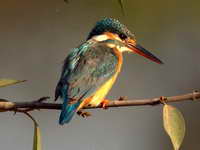



Kingfisher,_Half-collared Alcedo semitorquata
Description: The half-collared kingfisher has blue upperparts including the head. It has orange underparts and a white throat. There is a white neck-stripe that leads to the name "half-collared". Both sexes have black lores, but only the female has some red at the base of its black bill. It is similar to the malachite kingfisher which has rufous cheeks instead of blue cheeks. It is a medium sized kingfisher with a length of 18 cm and weight 35 to 40 grams.
Range: Eastern and southern Africa.
Habitat: Streams and rivers, reedy lakeshore, estuaries.
Diet: Small fish. Also crustaceans, insects, and frogs.
Conservation status: Least Concern.
Range: Eastern and southern Africa.
Habitat: Streams and rivers, reedy lakeshore, estuaries.
Diet: Small fish. Also crustaceans, insects, and frogs.
Conservation status: Least Concern.




Kingfisher,_Shining-blue Alcedo quadribrachys
Description: The shining-blue kingfisher has blue upperparts including the head. It has buffy lores, cream colored neck patch and throat. It has orange-chestnut underparts, a black bill, orange legs, and dark brown eyes. It is 16 cm long. Both pair excavate a nesting hole in a stream bank or similar place. It is most closely related to the half collared kingfisher which does not have buffy lores.
Range: The Shining-blue kingfisher is found in much of sub-Saharan Africa, as far south as Zambia.
Habitat: Streams, rivers and waterbodies; also lagoons, estuaries, and mangroves.
Diet: Mainly fish; also small crustaceans and insect larvae.
Conservation status: Least Concern.
Image by: 1) Tom Tarrant 2) Francesco_Veronesi - Uganda 3, 4) Nik_Borrow - GhanaRange: The Shining-blue kingfisher is found in much of sub-Saharan Africa, as far south as Zambia.
Habitat: Streams, rivers and waterbodies; also lagoons, estuaries, and mangroves.
Diet: Mainly fish; also small crustaceans and insect larvae.
Conservation status: Least Concern.




Genus Ceyx
All except one of the kingfishers in Ceyx have three rather than the usual four toes. The exception is the Sulawesi dwarf kingfisher which retains a vestigial fourth toe. Compared to the related kingfishers in the Alcedo genus, the Ceyx kinfishers are more terrestrial and their diet consists mainly of insects. These are small kingfishers - the majority are less than 15 cm long. Both partners help excavate nest-tunnels and incubate the eggs. The tunnels for these small species are usually less than 20 cm long. The species are found from South East Asia to the Solomon Islands.
Kingfisher,_Azure Ceyx azureus
Description: The azure kingfisher has an azure blue back and head. The blue extends to a small patch on each side of the breast. It has a white spot on side of the neck, rufous or white lores, rufous-buff underparts, black bill with a white tip, and red legs. It is 17 to 19 cm long and weighs 29 to 35 grams, with the female usually slightly larger than the male. Both pair excavate a nesting hole in a stream bank or similar place. Incubation takes about for about 3 weeks and the chicks fledge 3 to 4 weeks later. It is similar to the common kingfisher which has freckles on head while the azure kingfisher does not.
Range: Austrailia, New Guinea.
Habitat: Inland waterbodies near trees for perching and also coastal estuaries and lagoons.
Diet: Mainly small fish; also insects, frogs. Sits on a perch above water, dives into water, and returns to the perch with its prey.
Conservation status: Least Concern.
Image by: 1) JJ Harrison - Queensland 2) Brian_McCauley 3) Graham_Winterflood 4) David_Cook Range: Austrailia, New Guinea.
Habitat: Inland waterbodies near trees for perching and also coastal estuaries and lagoons.
Diet: Mainly small fish; also insects, frogs. Sits on a perch above water, dives into water, and returns to the perch with its prey.
Conservation status: Least Concern.




Kingfisher,_Bismarck Ceyx websteri
Description: The Bismarck kingfisher has a greenish-blue head and upperparts. The underparts are creamy white with pale orange on the breast. It has a white throat, white lores, black bill with white tip, and grey legs. It is 22 cm long. Both pair excavate a nesting hole in a stream bank or similar place. Incubation takes about for about 3 weeks and the chicks fledge 3 to 4 weeks later.
Range: Papua New Guinea.
Habitat: Subtropical or tropical moist lowland forests, rivers, freshwater lakes, and freshwater marshes.
Diet: Fish, crawfish, shrimp. Also insects, larvae.
Conservation status: It is listed as vulnerable because of its restricted range and forest degradation.
Image by:
1) John Gerrard Keulemans 2) Nik_BorrowRange: Papua New Guinea.
Habitat: Subtropical or tropical moist lowland forests, rivers, freshwater lakes, and freshwater marshes.
Diet: Fish, crawfish, shrimp. Also insects, larvae.
Conservation status: It is listed as vulnerable because of its restricted range and forest degradation.


Kingfisher,_Indigo-banded Ceyx cyanopectus
Description: The male Indigo-banded kingfisher has azure-blue upperparts, white freckles its azure-blue head, rufous underparts, rufous lores with white spot, whitish throat, white neck blaze, and red legs. The male has an indigo breast-band, the female does not.
Range: Philippines.
Habitat: Rivers and streams with trees for perching. Also found in mangroves near the coast.
Diet: Unknown.
Conservation status: One subspecies of the Indigo-banded kingfisher is listed as Leasted Concern and the other as Near Threatened because of habitat loss.
Image by: 1, 2) LlimchiuRange: Philippines.
Habitat: Rivers and streams with trees for perching. Also found in mangroves near the coast.
Diet: Unknown.
Conservation status: One subspecies of the Indigo-banded kingfisher is listed as Leasted Concern and the other as Near Threatened because of habitat loss.
1) Male


Kingfisher,_Little Ceyx pusillus
Description: The little kingfisher has blue upperparts, head, and flanks. The underparts are white and the feet are dark grey. It is one of the smallest kingfisher being 12 cm long and weighing approximately 13 grams.
Range: Australia, New Guinea and nearby islands.
Habitat: Open forest, woodland, swamps, and mangroves.
Diet: Fish, crustaceans, aquatic insects, larvae.
Conservation status: Least Concern.
Image by: 1) Katerina_Tvardikova 2) JJ Harrison - Queensland 3) Summerdrought - QueenslandRange: Australia, New Guinea and nearby islands.
Habitat: Open forest, woodland, swamps, and mangroves.
Diet: Fish, crustaceans, aquatic insects, larvae.
Conservation status: Least Concern.



Kingfisher,_Northern_Silvery Ceyx flumenicola
Description: The northern silvery kingfisher and southern silvery kingfisher were formerly considered conspecific and called the silvery kingfisher. It has mainly black upperparts with a whitish dorsal streak and white spots forming a discontinuous supercilium. There is a buff patch behind the ear-coverts, the throat is also buff as are the lores.
It has mainly blue underparts with a white belly. The bill is black, the feet red, and the eyes are brown. It is 14 cm in length and weighs 15 to 21 grams.
Range: Northern Philippines.
Habitat: Forested streams and forest edges near streams.
Diet: Small fish and crabs; also insects.
Conservation status: The northern silvery kingfisher is listed as Near Threatened because of deforestation and silted streams.
Image by:1) Sergey_YeliseevRange: Northern Philippines.
Habitat: Forested streams and forest edges near streams.
Diet: Small fish and crabs; also insects.
Conservation status: The northern silvery kingfisher is listed as Near Threatened because of deforestation and silted streams.

Kingfisher,_Oriental dwarf Ceyx erithaca
Description: The Oriental dwarf kingfisher, also known as the black-backed dwarf kingfisher, has a blue-black back and wings, lilac-rufous crown, a white throat, and yellow underparts. It has a red bill and legs. There is a black spot on the forehead and a white patch on the side of the neck. It is one of the smallest kingfishers with a length of 12 to 14 cm and weighs about 16 grams.
Range: Indian Subcontinent, southeast Asia, Indonesia, Malaysia.
Habitat: Primary and secondary forests, perferring to be near streams and ponds.
Diet: Insects such as grasshoppers and water beetles, fish, flies, frogs.
Conservation status: Least Concern.
Image by: 1) Shantanu_Kuveskar - India 2) Pkhun - southern Thailand 3) Shrikant_Rao - India 4 drcaesarphotography Range: Indian Subcontinent, southeast Asia, Indonesia, Malaysia.
Habitat: Primary and secondary forests, perferring to be near streams and ponds.
Diet: Insects such as grasshoppers and water beetles, fish, flies, frogs.
Conservation status: Least Concern.




Kingfisher,_Philippine_Dwarf Ceyx melanurus
Description: The Philippine dwarf kingfisher has lilac-rufous upperparts, head, and breast. It has black wings, plus a blue and white neck patch. The throat is white as is the belly. It has a red bill and legs. It is one of the smaller kingfishers with a length of 12 to 13 cm and a weight of 16 grams.
Range: Philippines.
Habitat: Forests. They may be found near streams, but not necessary.
Diet: Insects, larvae, crabs.
Conservation status:The Philippine dwarf kingfisher is listed as Vulnerable because of extensive deforestation.
Image by: 1) John_Gerrard_KeulemansRange: Philippines.
Habitat: Forests. They may be found near streams, but not necessary.
Diet: Insects, larvae, crabs.
Conservation status:The Philippine dwarf kingfisher is listed as Vulnerable because of extensive deforestation.

Kingfisher,_Rufous-backed Ceyx rufidorsa
Description: The rufous-backed kingfisher back and wings are mixtures of rufous and blue. There is a white patch on the the side of neck. It has a lilac-rufous crown, rump, and tail. The underparts are mainly orange with a small white patch on the chin. The bill and feet are red. It is 12.5 to 14 cm long and weighs about 16 grams with the male larger than the female.
Range: Southeast Asia, Indonesia, Malaysia, Phiippines.
Habitat: Forest, often near streams and ponds.
Diet: Insects, spiders, worms, crabs, fish, frogs.
Conservation status: Least Concern.
Image by:
1) Francesco Veronesi - Philippines 2) Mark BenedictRange: Southeast Asia, Indonesia, Malaysia, Phiippines.
Habitat: Forest, often near streams and ponds.
Diet: Insects, spiders, worms, crabs, fish, frogs.
Conservation status: Least Concern.


Kingfisher,_Southern_Silvery Ceyx argentatus
Description: The northern silvery kingfisher and southern silvery kingfisher were formerly considered conspecific and called the silvery kingfisher. It has mainly black upperparts with a white dorsal streak, and white spots forming a discontinuous supercilium. There is a white patch behind the ear-coverts, the throat is also white as are the lores.
It has mainly blue underparts with a white belly. The bill is black, the feet red, and the eyes are brown. It is 14 cm in length and weighs 18 to 24 grams.
Range: Southern Philippines.
Habitat: Forested streams and forest edges near streams.
Diet: Small fish and crabs; also insects.
Conservation status: The southern silvery kingfisher is listed as Near Threatened because of habitat degradation.
Image by: 1, 2) Francesco Veronesi 3) Nick_AthanasRange: Southern Philippines.
Habitat: Forested streams and forest edges near streams.
Diet: Small fish and crabs; also insects.
Conservation status: The southern silvery kingfisher is listed as Near Threatened because of habitat degradation.



Kingfisher,_Sulawesi Dwarf Ceyx fallax
Description: The Sulawesi dwarf kingfisher has numerous common names such as blue-crowned kingfisher, Celebes dwarf kingfisher, and Celebes pygmy-kingfisher. It has blue upperparts, a white throat, and rufous underparts. The bill and legs are red, The Sulawesi dwarf kingfisher is the only species of the Ceyx genus that does not have 3 toes, it has a vestigial 4th toe.
Range: Sulawesi Island of Indonesia.
Habitat: Prefers primary forests, but will tolerate selective timbering and tall secondary forests.
Diet: Unknown.
Conservation status: It is listed as Critically Endangered for one subspecies and Near Threatened for the other because of extensive forest destruction.
Image by: 1) Jason Thompson 2) Sergey_Yeliseev 3) AriefrahmanRange: Sulawesi Island of Indonesia.
Habitat: Prefers primary forests, but will tolerate selective timbering and tall secondary forests.
Diet: Unknown.
Conservation status: It is listed as Critically Endangered for one subspecies and Near Threatened for the other because of extensive forest destruction.



Former subspecies of variable dwarf kingfisher
The rest of the species in this Ceyx section were formerly considered to be a subspecies of the variable dwarf kingfisher which is now called the Moluccan dwarf kingfisher. These recently elevated species are located on islands, and due to their isolation they have evolved to have subtle differences from each other. They all have "dwarf" as part of their names as they are all small kingfishers, 12 to 15 cm in length. Because of the remote locations, few photographs are available for these species.
Kingfisher,_Buru_Dwarf Ceyx cajeli
Description: The Buru dwarf kingfisher has a bright pale blue back, rump, and upper-tail coverts. The rest of the upperparts are blackish-blue. The crown and wings have small dots of pale blue. It has a white patch on either side of the neck. The throat is white, the underparts orange, and the bill is red. It is a small kingfisher, only 14 cm long.
Range: Buru Island in Indonesia.
Habitat: Forests, not necessariy near water.
Diet: Very small fish taken from ditches and ponds; also aquatic invertebrates.
Conservation status: The Buru dwarf kingfisher is listed as Near Threatened because it is restricted to one island where it is experiencing habit loss.
Image by: 1) Joseph_Wolf Range: Buru Island in Indonesia.
Habitat: Forests, not necessariy near water.
Diet: Very small fish taken from ditches and ponds; also aquatic invertebrates.
Conservation status: The Buru dwarf kingfisher is listed as Near Threatened because it is restricted to one island where it is experiencing habit loss.

Kingfisher,_Diomorphic_Dwarf Ceyx margarethae
Description: The Diomorphic dwarf kingfisher has a dark and pale morph, hence its name. Both have bright rufous lores, malar stripe, and breast-sides; and there is a white patch behind the ear coverts. The throat is white. It has orange feet and an orange bill. The head, back, rump, wing and upper-tail coverts can be pale or dark blue mixed with some black. It is a small kingfisher, only 15 cm long.
Range: Central and southern Philippines.
Habitat: Forests, not necessarily near water.
Diet: Small fish, insects.
Conservation status: Least Concern.
Image by: 1) Philippine_Postal_CorporationRange: Central and southern Philippines.
Habitat: Forests, not necessarily near water.
Diet: Small fish, insects.
Conservation status: Least Concern.

Kingfisher,_Guadalcanal_Dwarf Ceyx nigromaxilla
Description: The Guadalcanal dwarf kingfisher has dark blue upperparts and rufous-orange underparts. The black bill has an orange base and the feet are orange-red. There is a small white patch behind the ear-coverts and it has a white throat.
It is a small kingfisher, only 14 cm long and about 18 grams.
Range: Guadalcanal.
Habitat: Forests, not necessarily near water.
Diet: Unavailable.
Conservation status: Least Concern.
Image not available.Range: Guadalcanal.
Habitat: Forests, not necessarily near water.
Diet: Unavailable.
Conservation status: Least Concern.
Kingfisher,_Makira_Dwarf Ceyx gentianus
Description: The Makira dwarf kingfisher is quite different from the other species of the variable dwarf kingfisher complex. It has blue upperparts, white underparts, white lores, and a white neck patch. The bill is black. It is 14 cm long.
Range: Makira island of the Solomon Islands.
Habitat: Forests, not necessarily near water.
Diet: Unknown.
Conservation status: Least Concern.
Image by: 1) John_Gerrard_Keulemans Range: Makira island of the Solomon Islands.
Habitat: Forests, not necessarily near water.
Diet: Unknown.
Conservation status: Least Concern.

Kingfisher,_Malaita_Dwarf Ceyx malaitae
Description: The Malaita dwarf kingfisher has dark blue upperparts, rufous-orange underparts, and a small white patch behind the ear-coverts. There are speckles on the crown and a light blue dorsal stripe. The bill is mainly black with orange at the base. It has a white throat and orange feet. It is 14 cm long and 17 to 19 grams.
Range: Malaita island of the Solomon Islands.
Habitat: Forests, not necessarily near water.
Diet: Unknown.
Conservation status: Least Concern.
No image available.Range: Malaita island of the Solomon Islands.
Habitat: Forests, not necessarily near water.
Diet: Unknown.
Conservation status: Least Concern.
Kingfisher,_Manus_Dwarf Ceyx dispar
Description: The male Manus dwarf kingfisher has dark blue upperparts, rufous-orange underparts, and a small white patch behind the ear-coverts. The similar female has most of the head orange with some blue on the crown. They both have a red bill and a white throat. It is 14 cm long and about 20 grams. The male Manus dwarf kingfisher is similar to the New Georgia dwarf kingfisher.
Range: Admiralty Islands of New Guinea.
Habitat: Forests, not necessarily near water.
Diet: Unknown.
Conservation status: The Manus dwarf kingfisher is listed as Near Threatened because its population is unknown and It habitat is under pressure from logging.
No image available.Range: Admiralty Islands of New Guinea.
Habitat: Forests, not necessarily near water.
Diet: Unknown.
Conservation status: The Manus dwarf kingfisher is listed as Near Threatened because its population is unknown and It habitat is under pressure from logging.
Kingfisher,_Moluccan_Dwarf Ceyx lepidus
Description: The Moluccan dwarf kingfisher, also known as the Seram dwarf kingfisher, has dark blue upperparts with a light blue dorsal stripe, rufous-orange underparts, and a small white patch behind the ear-coverts. There are speckles on the crown and wing-coverts. It has a red bill, an orange loral spot, and a white throat. It is 14 cm long.
Range: Maluku Islands.
Habitat: Primary forests and dense secondary forests, often near streams.
Diet: Insects, spiders, small frogs. Sits ona low branch, rock, etc. looking for prey which it may take in the air or on the ground.
Conservation status: Least Concern.
Image by: 1) Hectonichus - photo of a displayRange: Maluku Islands.
Habitat: Primary forests and dense secondary forests, often near streams.
Diet: Insects, spiders, small frogs. Sits ona low branch, rock, etc. looking for prey which it may take in the air or on the ground.
Conservation status: Least Concern.
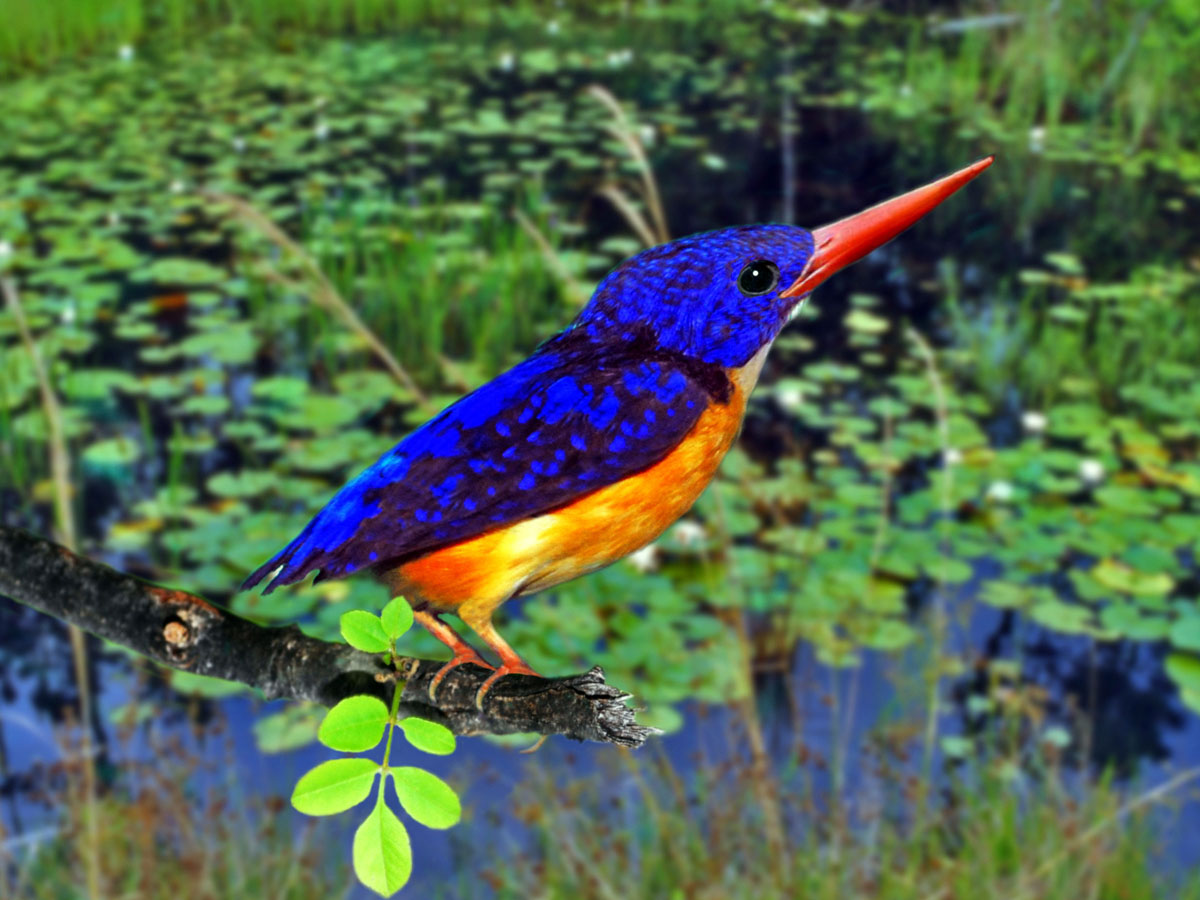
Kingfisher,_New_Britain_Dwarf Ceyx sacerdotis
Description: The New Britain dwarf kingfisher has dark blue upperparts, rufous-orange underparts, and a small white patch behind the ear-coverts. There are speckles on the crown and wing-coverts. It has orange-buff loral spot and a pale yellow throat. The bill is dark above and orange below. It is 14 cm long and 17 to 20 grams.
Range: New Britain and Umboi Island of New Guinea.
Habitat: Forests, not necessarily near water.
Diet: Unknown.
Conservation status: Least Concern.
No image available.Range: New Britain and Umboi Island of New Guinea.
Habitat: Forests, not necessarily near water.
Diet: Unknown.
Conservation status: Least Concern.
Kingfisher,_New_Georgia_Dwarf Ceyx collectoris
Description: The New Georgia dwarf kingfisher has dark blue upperparts with a light blue dorsal stripe, rufous-orange underparts, and a small white patch behind the ear-coverts. There are speckles on the crown and wing-coverts. The bill is dark above and orange below. The throat is white. It is 14 cm long.
Range: West central Solomon Islands.
Habitat: Forests, not necessariy near water.
Diet: Unknown.
Conservation status: Least Concern.
No image availableRange: West central Solomon Islands.
Habitat: Forests, not necessariy near water.
Diet: Unknown.
Conservation status: Least Concern.
Kingfisher,_New_Ireland_Dwarf Ceyx mulcatus
Description: The New Ireland dwarf kingfisher has dark blue upperparts with a light blue dorsal stripe, pale orange underparts, and a small white patch behind the ear-coverts. There are speckles on the crown and wing-coverts. It has a black bill, an orange-buff loral spot, and a pale yellow throat. It is 14 cm long and weighs 15 to 22 grams.
Range: New Hanover Island, New Ireland, and the Lihir Islands which are part of the Bismarck Archipelago of New Guinea..
Habitat: Primary forests and dense secondary forests, often near streams.
Diet: Unknown.
Conservation status: Least Concern.
No image availableRange: New Hanover Island, New Ireland, and the Lihir Islands which are part of the Bismarck Archipelago of New Guinea..
Habitat: Primary forests and dense secondary forests, often near streams.
Diet: Unknown.
Conservation status: Least Concern.
Kingfisher,_North_Solomons_Dwarf Ceyx meeki
Description: The North Solomons dwarf kingfisher has dark blue upperparts with a light blue dorsal stripe, yellowish underparts, and a small white patch behind the ear-coverts. There are speckles on the crown and wing-coverts. It has a black bill, a pale loral spot, white throat, and yellow legs. It is 14 cm long. It is similar to the Papuan dwarf kingfisher but the North Solomons dwarf kingfisher has darker upperparts and paler underparts.
Range: Solomon Islands.
Habitat: Primary forests and dense secondary forests.
Diet: Unknown.
Conservation status: Least Concern.
Image by: 1) John_Gerrard_KeulemansRange: Solomon Islands.
Habitat: Primary forests and dense secondary forests.
Diet: Unknown.
Conservation status: Least Concern.

Kingfisher,_Papuan_Dwarf Ceyx solitarius
Description: The Papuan dwarf kingfisher has dark blue upperparts with a light blue dorsal stripe, golden underparts, and a small white patch behind the ear-coverts. There are speckles on the crown and wing-coverts. It has a black bill, pale loral spot, white throat, and yellow legs. It is 12 cm long, male 11 to 21 grams, and female 13 to 24 g. The azure kingfisher, also found on New Guinea, is larger and has more uniformly blue upperparts.
Range: New Guinea.
Habitat: Forests, not necessarily near water.
Diet: Mainly insects such as grasshoppers. Also spiders, tadpoles. It has never been observed to dive into water for food.
Conservation status: Least Concern.
Image by: 1) Oort 2) Charles_Davies - Varirata National Park 3) Nik_Borrow - Elevala RiverRange: New Guinea.
Habitat: Forests, not necessarily near water.
Diet: Mainly insects such as grasshoppers. Also spiders, tadpoles. It has never been observed to dive into water for food.
Conservation status: Least Concern.



Kingfisher,_Sula_Dwarf Ceyx wallacii
Description: The Sula dwarf kingfisher has dark blue upperparts with a light blue dorsal stripe, orange underparts, and a small white patch behind the ear-coverts. There are speckles on the crown and wing-coverts. It has a red bill, orange loral spot, white throat, and orange legs. It is 14 cm long, It is the only kingfisher with a red bill in its range.
Range: Sula Islands in Indonesia.
Habitat: Forests.
Diet: Unknown.
Conservation status: The Sula dwarf kingfisher is listed as Near Threatened because of extensive destruction of primary forests.
Image by: 1) Richard_Bowdler_SharpeRange: Sula Islands in Indonesia.
Habitat: Forests.
Diet: Unknown.
Conservation status: The Sula dwarf kingfisher is listed as Near Threatened because of extensive destruction of primary forests.

Genus Corythornis
These small African kingfishers are all about 13 cm long. Both partners help excavate nest-tunnels and incubate the eggs. The tunnels for these small species average about 40 cm long.
Kingfisher,_Madagascar Pygmy Corythornis madagascariensis
Description: The Madagascar pygmy kingfisher has rufous upperparts with a llac tinge to the lower back and upper-tail coverts. The rear of the head also has a lilac tinge. It has white underparts and there is a small white patch behind the ear-coverts. The bill and legs are orange. It is 13 cm long and weighs 17 to 22 grams. The pair excavates a nest-tunnel 30 to 35 cm long and they both incubate the eggs.
Range: Madagascar.
Habitat: Scrubland, wooded savanna, forest edges. Waterbodies do not need to be close by.
Diet: Frogs and insects.
Conservation status: Least Concern.
Image by: 1, 2) Frank Vassen - Mantadia National Park, Madagascar 3) Pat and Keith Taylor - Mantadia National ParkRange: Madagascar.
Habitat: Scrubland, wooded savanna, forest edges. Waterbodies do not need to be close by.
Diet: Frogs and insects.
Conservation status: Least Concern.



Kingfisher,_Malachite Corythornis cristatus
Description: The malachite kingfisher has blue upperparts, blue and black head, rufuos cheeks, and rufous underparts. It has a white patch on the throat and also a white patch on the rear side of the neck, The bill is reddish-orange and the legs are red. It is about 13 cm long. The similar Malagasy kingfisher has a black bill as does the half collared kingfisher. The similar African pygmy kingfisher has a rufous supercilium.
Range: Sub-Saharan Africa.
Habitat: Aquatic vegetation near slow-moving water or ponds.
Diet: Mainly fish; also insects.
Conservation status: Least Concern.
Image by: 1, 2) Arno Meintjes 3) Hans Hillewaert 4) Nik_Borrow - EthiopiaRange: Sub-Saharan Africa.
Habitat: Aquatic vegetation near slow-moving water or ponds.
Diet: Mainly fish; also insects.
Conservation status: Least Concern.




Kingfisher,_Malagasy Corythornis vintsioides
Description: The Malagasy kingfisher has blue upperparts, blue and black head, rufuos cheeks, and rufous underparts. It has a white patch on the throat and there is a small white patch behind the ear-coverts.. The bill is black, the lores are red, and the legs are red. It is 13 cm long. The simila rto the malachite kingfisher which has a reddish-orange bill.
Range: Madagascar.
Habitat: Near freshwater; also near the coast.
Diet: Fish, frogs, crustaceans, insects.
Conservation status: Least Concern.
Image by: 1, 2, 3)
Frank Vassen - Madagascar 4) Dick Daniels - Parc Tsarasaotra, an open bird sanctury in AntananrivoRange: Madagascar.
Habitat: Near freshwater; also near the coast.
Diet: Fish, frogs, crustaceans, insects.
Conservation status: Least Concern.



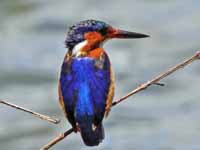
Kingfisher,_White-bellied Corythornis leucogaster Found: Africa
Description: The white-bellied kingfisher has blue upperparts, rufous checks, rufous breast with a white center region, and a white belly. It has a white patch on the throat and there is a small white patch behind the ear-coverts.. The legs and bill are red. It is 13 cm long. The juvenile has a black bill.
Range: Equatorial west Africa.
Habitat: Forests and dense thickets near fresh or salt water.
Diet: Fish, aquatic and terrestrial insects, wasps, spiders, earthworms, frogs.
Conservation status: Least Concern.
Image by: 1) Francesco_Veronesi - Ghana 2) Roger Peet 3) Nik_Borrow - GhanaRange: Equatorial west Africa.
Habitat: Forests and dense thickets near fresh or salt water.
Diet: Fish, aquatic and terrestrial insects, wasps, spiders, earthworms, frogs.
Conservation status: Least Concern.
1) Juvenile



Genus Ispidina
These two species are small African kingfishers. Both partners help excavate nest-tunnels and incubate the eggs. The tunnels for these small species average about 20 cm long.
Kingfisher,_African Dwarf Ispidina lecontei
Description: The African dwarf kingfisher has blue upperparts, white throat, rufous crown, and rufous underparts. The head is rufous and there is a black forehead. It has a white throat patch and there is a small white patch behind the ear-coverts. It is the world's smallest kingfisher with a length of 10 cm. The male weights 9 to 11 grams with the female slightly heavier. The similar African pygmy kingfisher has a dark blue crown while this dwarf has a rufous crown.
Range: Western and central Africa.
Habitat: Forests, dense undergrowth. It does not need to be near streams etc.
Diet: Insects, larvae, flies. Sits on a low perch and will take prey in the air or on the ground.
Conservation status: Least Concern.
Image by: 1) Nik_Borrow - Ghana 2) Nik_Borrow - UgandaRange: Western and central Africa.
Habitat: Forests, dense undergrowth. It does not need to be near streams etc.
Diet: Insects, larvae, flies. Sits on a low perch and will take prey in the air or on the ground.
Conservation status: Least Concern.


Kingfisher,_African Pygmy Ispidina picta Found: Africa
Description: The African pygmy kingfisher has blue upperparts, dark blue crown, violet ear swath, rufous underparts and a rufous supercilium. It has a white throat patch and there is a small white patch behind the ear-coverts. It is slightly larger than the African dwarf kingfisher with a length of 12 cm. The similar African dwarf kingfisher has a rufous crown while this pygmy has a dark blue crown. The similar malachite kingfisher does not have a rufous supercilium.
Range: Central and southern Africa.
Habitat: Woodland, savanna and coastal forest; it is not bound to water.
Diet: Insects such as grasshoppers and praying mantis; worms, crickets, dragonflies, cockroaches and moths. Also spiders, frogs, lizards. Hunts from low perches.
Conservation status: Least Concern.
Image by: 1) Steve Garvie - Abuko, The Gambia 2) Yoky - Lake Manyara National Park, Tanzania 3, 4) Nik_Borrow - EthiopiaRange: Central and southern Africa.
Habitat: Woodland, savanna and coastal forest; it is not bound to water.
Diet: Insects such as grasshoppers and praying mantis; worms, crickets, dragonflies, cockroaches and moths. Also spiders, frogs, lizards. Hunts from low perches.
Conservation status: Least Concern.



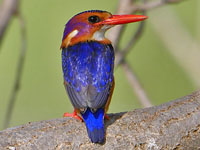
Genus Lacedo - 1 species
Kingfisher,_Banded Lacedo pulchella
Description: The male banded kingfisher has a chestnut forehead, cheeks, and nape. He has black upperparts with light blue bands. The underparts are rufous with a whitish central belly. The female has black-and-rufous banded upperparts, white underparts with some black bars on the breast and flanks. It is 20 to 24 cm long, male weighs 40 to 48 grams, and female weighs 46 to 54 grams.
Range: Southeast Asia, Malaysia.
Habitat: Forests, including second growth. Nest usually excavated in a rotting tree trunk.
Diet: Insects such as grasshoppers, beetles, centapedes. Also fish. Obtains most prey in the foliage.
Conservation status: Least Concern.
Image by:1) Nina_R 2) Tontan_Travel 3) Francesco Veronesi - Thailand 4) Jason Thompson - Thailand Range: Southeast Asia, Malaysia.
Habitat: Forests, including second growth. Nest usually excavated in a rotting tree trunk.
Diet: Insects such as grasshoppers, beetles, centapedes. Also fish. Obtains most prey in the foliage.
Conservation status: Least Concern.
1, 2) Female 3, 4) Male
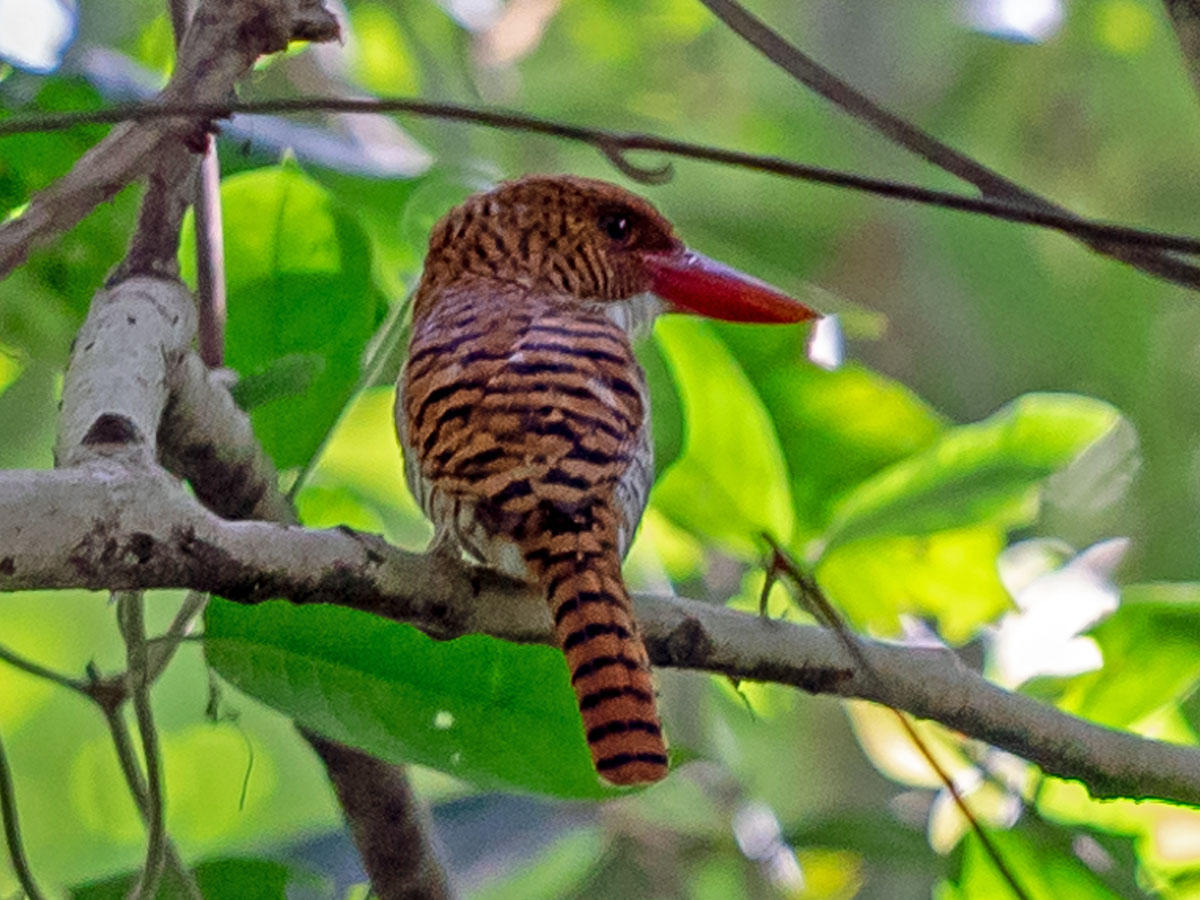


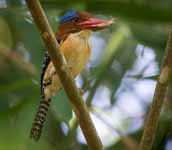
Genus Pelargopsis
These are very large kingfishers. Their flight is flapping, but direct. They inhabit well wooded habitats near water. They are territorial and will chase away eagles and other large predators. These species hunts crabs, fish, frogs, Sexes are similar. Both partners help excavate nest-tunnels and incubate the eggs. The tunnels average about 40 cm long.
Kingfisher,_Brown-winged Pelargopsis amauroptera
Description: The brown-winged kingfisher has brown upperparts, orange-buff head and underparts, red bill with darker end, and a blue rump. It is 35 to 37 cm long and weighs about 160 grams.
Range: Bangladesh, India, southeast Asia, Malaysia .
Habitat: Coastal, especially where there are mangroves for perching.
Diet: Fish and crabs which are usually sighted from a mangrove perch.
Conservation status: The brown-winged kingfisher is listed as Near Threatened because of a small population and clearing of trees that they favor.
Image by: 1) Jayanth Shama - India 2) Allan Drewitt - Thailand 3) Darren - Thailand 4) AjitK332Range: Bangladesh, India, southeast Asia, Malaysia .
Habitat: Coastal, especially where there are mangroves for perching.
Diet: Fish and crabs which are usually sighted from a mangrove perch.
Conservation status: The brown-winged kingfisher is listed as Near Threatened because of a small population and clearing of trees that they favor.

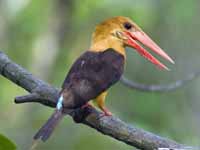


Kingfisher,_Great-billed Pelargopsis melanorhyncha
Description: The great-billed kingfisher, also known as the black-billed kingfisher, has a white head and mantle. There is some darkness around the eyes. The breast is white with some dark spots. The underparts become yellowish towards the belly. It has a heavy dark bill. It is a large kingfisher at 35 cm long, male 180 grams, and female 200 g.
Range: Island of Sulawesi and in the Sula Archipelago.
Habitat: Coastal area especially with mangroves. Also inland near wooded streams and ponds.
Diet: Crabs, crawfish. Perches in a tree above water.
Conservation status: Least Concern.
Image by: 1, 2) AS Kono 3) Sergey_YeliseevRange: Island of Sulawesi and in the Sula Archipelago.
Habitat: Coastal area especially with mangroves. Also inland near wooded streams and ponds.
Diet: Crabs, crawfish. Perches in a tree above water.
Conservation status: Least Concern.



Kingfisher,_Stork-billed Pelargopsis capensis
Description: The stork-billed kingfisher has greenish-blue upperparts, a grey head, whitsh chin, buff neck, and buff underparts. The legs and large bill are red. It is 35 to 41 cm long, male 145 to 180 grams, and female 180 to 225 grams.
Range: India, souheast Asia, Indonesia, Malaysia, Philippines.
Habitat: Lowland forests (inland or coastal) near water.
Diet: Fish, crustacean. Also frogs, lizards, young birds.
Conservation status: Least Concern.
Image by: 1) Lip Kee - Singapore 2) David Cook - Sri Lanka 3, 4) LonelyShrimp - ThailandRange: India, souheast Asia, Indonesia, Malaysia, Philippines.
Habitat: Lowland forests (inland or coastal) near water.
Diet: Fish, crustacean. Also frogs, lizards, young birds.
Conservation status: Least Concern.




